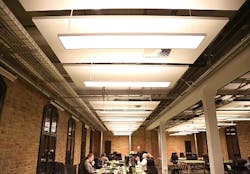No light switches at Cisco's own Berlin smart building, where you can't miss the IoT
With 10,000 sensors and 100 people at Cisco’s innovation center, the networking giant practices what it preaches when it comes to IoT and connected lighting.
BERLIN – One test of how much a technology company believes in its own stuff is whether it uses the gear itself. To that end, Cisco is rising to the occasion in smart lighting. As reported earlier by LEDs Magazine, the networking giant has deployed Power over Ethernet lighting at several of its main corporate offices, including corporate headquarters in San Jose, as well as at a regional center in Toronto. Its UK headquarters office in London will soon follow.
Interested in more articles & announcements on connected lighting?
And to further demonstrate that it is indeed a big believer in intelligent, networked lighting, Cisco recently showed off a connected lighting project to journalists here as part of a tour of its openBerlin facility.
openBerlin is one of nine Cisco innovation centers around the world where Cisco and startups hash out ideas and co-develop next-generation networking technologies such as smart lighting.
The ceiling panels at Cisco's openBerlin center respond to network commands for on/off, brightness, color, and color temperature. Source: Sabine Lobmeier via Cisco.
As with Cisco in general these days, the facility has a distinct Internet of Things (IoT) flavor. openBerlin is housed in a three-story (counting the funky attic) red-brick former gas company building, and it's part of an emerging, modern culture at Cisco that feels more Apple tech-hip than it does boring, old dyed-in-the-wool networking. openBerlin exudes touches you might expect for such a place: facial recognition security systems (they even work sometimes), outdoor tree houses that serve as meeting areas, a cozy cafe full of homey, reclaimed wooden chairs and tables that invite collaboration, and a “no-shoes” romper room up in the loft decked out with hammocks, cushions, and futons meant to make things comfortable for the geeks that camp out during the occasional 48-hour hackathon.
But there's one thing you won't find.
“You don't see any light switches here,” said Bernd Heinrichs, managing director of Internet of Everything (IoE) Sales for the EMEAR and for openBerlin Innovation Centre. “Everything is automated. Heating, air conditioning, the lights, et cetera...All of it's done by a huge amount of sensors.”
Really? How many sensors?
“We have 5000 sensors installed now, and we probably will go to 10,000 very soon,” Heinrichs said. With a capacity of about 100 people in the nearly 13,000-square foot building, that would work out to about 100 sensors per person — more on a typical day when the building has fewer than 100 individuals knocking about.
The sensors — largely from German supplier Bosch — are peppered around the walls and ceilings, in some cases hidden away in or near connected lighting fixtures. Some automatically adjust light settings depending on room occupancy, but they're not all for lighting per se. They detect not only room occupancy but climatic conditions like room temperature. They feed data about what they notice into the building's central IT systems, which in turn can trigger actions such as turning the heating or cooling system on, off, up, or down.
On the second floor, users can change not only on/off and brightness settings but also the color and color temperature of the ceiling panel LED luminaires via network commands, a hallmark of PoE lighting. Occupants on the ground floor, which utilizes hanging, stylish ceiling bulbs rather than panel lights, have to settle for remotely controlling on/off and brightness.
At openBerlin, Cisco has worked with two behind-the-scenes Berlin-based technology providers, Relayr and Azeti, to install software and hardware that connects lighting and other building systems to networks.
The openBerlin tour coincided with Cisco's Cisco Live! exhibition, which attracted over 12,000 users, partners, app developers, and other visitors here last week with a heavy IoT focus, and which featured a “digital ceiling” and the company emphasizing lighting and lighting partnership with companies such as Philips, Cree, NuLEDs, Innovative Lighting, and Platformatics.
Cisco CTO Zorawar Biri Singh says there will be hundreds of billions of sensors and actuators connected to the Internet. Lighting will be an important part. Source: Sabine Lobmeier via Cisco.
For Cisco, the IoT represents a huge opportunity to sell more networking gear such as routers and switches that would support a wide array of new thing-to-thing and people-to-thing communications. Cisco wants developers to write IoT applications that would reside on Cisco routers to support IoT functions — such as connected lighting — on premises, rather than pushing the apps further back in the network, where they might slow down communications.
In a Cisco Live! keynote address, Cisco chief technology officer Zorawar Biri Singh said there will soon be hundreds of billions of sensors and actuators connected to the net. Adam Philpott, director of cybersecurity for Cisco’s EMEAR region, said the world is spending $2.5 million per second outfitting the IoT, where there will be 500 billion things connected by 2030.
MARK HALPERis a contributing editor for LEDs Magazine, and an energy, technology, and business journalist ([email protected]).






